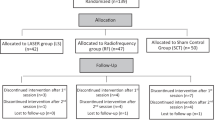Abstract
This pilot clinical trial was performed to evaluate the safety and impact on quality of life and incontinence episode frequency of nonsurgical radiofrequency energy (RF) tissue micro-remodeling in women with stress urinary incontinence (SUI). The palpation-guided treatment produces focal denaturation of submucosal collagen, resulting in reduced luminal wall compliance without luminal narrowing. Forty-one women suffering from SUI associated with urethral hypermobility were enrolled into four treatment groups which differed in total number and lower urinary tract location of micro-remodeling sites. No serious and only limited minor adverse events were associated with the treatment. Incidence of quality of life score improvement at 12 months ranged from 75 to 78%, and statistically significant incontinence episode frequency reduction was demonstrated by three of four treatment groups. RF micro-remodeling demonstrated 12-month safety, quality of life improvement, and incontinence episode frequency reduction. No one treatment group demonstrated clear superiority in efficacy outcomes.

Similar content being viewed by others
References
U.S. Markets for Incontinence Management Products (#RP-191129). Medical Data International, May 2002
Robinson D, Anders K, Cardozo L et al (2002) What women want—their interpretation of the concept of cure (abstract 115). International Continence Society Annual Meeting
Zlotta AR, Giannakopoulos X, Maehlum O et al (2003) Long-term evaluation of transurethral needle ablation of the prostate (TUNA) for treatment of symptomatic benign prostatic hyperplasia: clinical outcome up to five years from three centers. Eur Urol 44:89–93
Dequesne JH, Gallinat A, Garza-Leal JG et al (1997) Thermoregulated radiofrequency endometrial ablation. Int J Fertil Womens Med 42:311–318
Takahashi T, Garcia-Osogobio S, Valdovinos MA et al (2003) Extended two-year results of radio-frequency energy delivery for the treatment of fecal incontinence (secca procedure). Dis Colon Rectum 46:711–715
Triadafilopoulos G (2003) Stretta: an effective, minimally invasive treatment for gastroesophageal reflux disease. Am J Med 155 [Suppl 3A]:192S-200S
Sotomayor M, Feria-Bernal G (2003) Transurethral delivery of radiofrequency energy for tissue micro-remodeling in the treatment of stress urinary incontinence. Int Urogynecol J 14:373–379
Wagner TH, Patrick DL, Bavendam TG et al (1996) Quality of life of persons with urinary incontinence: development of a new measure. Urology 47:67–71
Donovan JL, Bdia X, Corcos J et al (2002) Symptom and quality of life assessment. In: Abrams P, Cardozo L, Khoury S, Wein A (eds) 2nd International Consultation on Incontinence. Health Publications, Plymouth, UK, pp 267–316
Patrick DL, Martin ML, Bushnell DM et al (1999) Quality of life of women with urinary incontinence: further development of the Quality of Life Instrument (I-QOL). Urology 53:71–76
Acknowledgement
This study was sponsored by Novasys Medical, Inc., Newark, California, USA.
Author information
Authors and Affiliations
Corresponding author
Additional information
The institution received financial support for the performance of the study from the sponsor. Neither author has an equity position in the sponsoring company nor received direct financial support
A limited portion of these study results was presented in poster (abstract) form at the International Continence Society Meeting, Florence, Italy, 2003
Editorial Comment: This is an interesting 1-year follow-up on a study involving a minimally invasive radiofrequency technique for shrinking periurethral collagen and providing relief of stress urinary incontinence. The first publication of these patients appeared in volume 14 of this journal, but only had 6-month data. It is encouraging to see that the data at 12 months remain positive. Except for the group II patients, all of the I-QOL scores remain essentially unchanged. While it appears there is an increase in the incontinence episode frequency from 6 months to 12 months, particularly in group IV, overall there is a good reduction in incontinent episode frequency. This in combination with no change in I-QOL scores is encouraging that the treatment remains effective at 1 year. These data are interesting and we wish the authors success in their phase III study
Rights and permissions
About this article
Cite this article
Sotomayor, M., Bernal, G.F. Twelve-month results of nonsurgical radiofrequency energy micro-remodeling for stress incontinence. Int Urogynecol J 16, 192–196 (2005). https://doi.org/10.1007/s00192-004-1223-z
Received:
Accepted:
Published:
Issue Date:
DOI: https://doi.org/10.1007/s00192-004-1223-z




